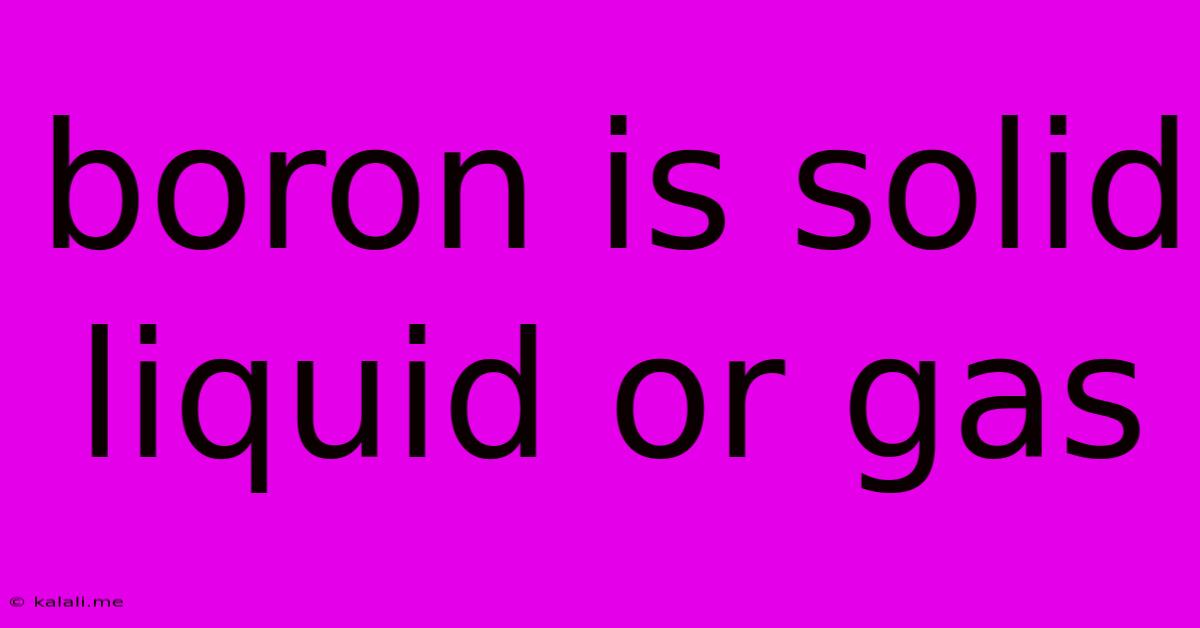Boron Is Solid Liquid Or Gas
Kalali
May 10, 2025 · 3 min read

Table of Contents
Boron: Solid, Liquid, or Gas? Understanding Boron's State of Matter
Boron, a metalloid element crucial in various industrial and biological processes, exists primarily as a solid at room temperature and standard pressure. This article will delve deeper into boron's properties and explore why it's found in its solid form under typical conditions. Understanding boron's state of matter helps us appreciate its unique characteristics and applications.
Boron's Unique Properties and its Solid State
Boron's position on the periodic table, nestled between metals and nonmetals, contributes to its unique properties. Unlike many other elements, boron doesn't readily form simple molecules like O₂ or N₂. Instead, it forms complex structures with strong covalent bonds between boron atoms, resulting in a hard, crystalline solid. This intricate bonding structure gives boron its characteristic high melting point (around 2076°C or 2349K) and high hardness, making it resistant to changes in its physical state under normal circumstances.
The Factors Affecting State of Matter
The state of matter of any substance is determined by several key factors:
-
Temperature: Increased temperature provides molecules with more kinetic energy, overcoming intermolecular forces and causing transitions from solid to liquid (melting) and liquid to gas (boiling). Boron's exceptionally high melting point highlights the strength of its atomic bonds.
-
Pressure: Higher pressure forces molecules closer together, favoring the solid or liquid state. While pressure can influence the melting and boiling points slightly, it's not the primary factor determining boron's solid state at room temperature.
-
Intermolecular Forces: The strong covalent bonds within boron's crystal structure are the dominant intermolecular forces, requiring significant energy to break and transition to a liquid or gaseous state.
Boron's Applications: A Solid Performer
Boron's solid form is essential for its numerous applications, including:
-
High-strength materials: Boron fibers, for instance, are used in aerospace and military applications due to their exceptional strength-to-weight ratio.
-
Semiconductors: Boron's semiconducting properties find use in electronics.
-
Nuclear reactors: Boron isotopes play a vital role in controlling nuclear reactions.
-
Agricultural fertilizers: Boron compounds are essential micronutrients for plant growth.
Rare Exceptions: Liquid and Gaseous Boron
While boron exists primarily as a solid, it is possible to achieve liquid and gaseous states under extreme conditions. This requires significantly elevated temperatures well beyond what is encountered in everyday life. At exceptionally high temperatures and pressures, boron can melt into a liquid and subsequently vaporize into a gas. However, these are highly specialized scenarios, not commonly encountered.
Conclusion: Boron's Solid Nature
In summary, boron exists predominantly as a solid at standard temperature and pressure. This is a direct consequence of its strong covalent bonds and intricate crystal structure, which require considerable energy to overcome. While liquid and gaseous boron can exist under extreme conditions, its solid form is the most prevalent and practically relevant for its wide range of applications. Understanding this fundamental aspect of boron's properties is key to appreciating its unique role in various fields.
Latest Posts
Latest Posts
-
How Far Is 220 Yards On A Track
Jul 02, 2025
-
What Is The Shortest Chapter In The Bible
Jul 02, 2025
-
What Has 4 Letters Sometimes Has 9
Jul 02, 2025
-
How Many Milliliters In A Half Gallon
Jul 02, 2025
-
How Much Can I Sell Bro For
Jul 02, 2025
Related Post
Thank you for visiting our website which covers about Boron Is Solid Liquid Or Gas . We hope the information provided has been useful to you. Feel free to contact us if you have any questions or need further assistance. See you next time and don't miss to bookmark.